Just north-west of Johannesburg is a new 47,000-hectare World Heritage Site called the 'Cradle of Humankind'. The valley embraces 15 significant sites of ancient fossil finds which document the evolution of hominins, constituting about a third of all the world's human ancestor fossils. On 7 December 2005, a new visitors' centre called 'Maropeng' was opened there. 'Maropeng' is a Setswanan word for 'returning to the place of origin', which is to remind us that 'humans, wherever they may live today, originally came from Africa'. The South African President, Thabo Mbeki, officiated at the opening and 'welcomed everyone home'. In this new exhibition, a scientific creation story is given explicitly political expression. What are the uses of the deep past in contemporary South Africa, a nation trying to shed its apartheid past and seeking to foster 'an African renaissance'?
This paper emerged from a dialogue between an Australian (Tom Griffiths) and a South African (Vincent Carruthers) who together visited Maropeng shortly after its opening.
____________________________________________________
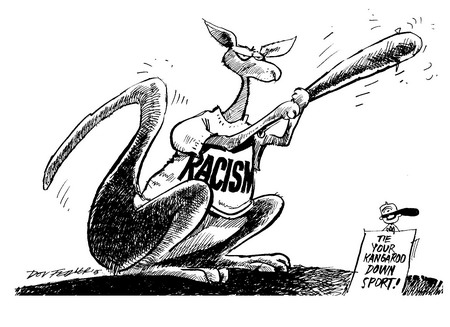
South Africans must certainly get tired of talking about apartheid, particularly to foreigners. Aren't they allowed to shed that past yet? Twelve years after they embraced democracy, this recent political history continues to fascinate and haunt visitors and residents alike. Many South Africans fear that the struggle against racism has still to be won, and others are concerned that the new government's assertive policies of retribution and black economic empowerment are degenerating into a sort of inverted apartheid.
My first full day in Johannesburg was Dingane's Day, a day of Afrikaner commemoration and a national holiday. Dingane was a Zulu chief who, in the 1830s, played a murderous trick on the Voortrekkers being led into Natal by Piet Retief. Pretending to agree to a land treaty with them, King Dingane invited Retief and his party to a celebration, but instead of partying with them he killed them and despatched warriors to massacre the unsuspecting trekker families. Soon afterwards the Voortrekkers vowed revenge. They also vowed that if God would give their 500 men with guns an unlikely victory over the 10,000 Zulu warriors, then they would religiously give that day to thanksgiving and keep it as a Sabbath. The Boers formed their wagons into a circle — a laager — and from behind this makeshift fort their firepower was devastating. The river ran red with Zulu blood. This stunning triumph at the Battle of Blood River on 16 December 1838 seemed proof that the Afrikaner occupation of inland southern Africa had divine sanction — and their defensive laager was to become 'the symbol of their military strategy and ultimately of their mentality as well'.[4] Afrikaner nationalism had gained a sacred date — 16 December, the Day of the Covenant, informally known as Dingane's Day — and in the twentieth century it was also to create a sacred place, a shrine, to celebrate this day and all it represented — the Voortrekker Monument in Pretoria. It was built between 1938 and 1949 and opened at the time of the political inauguration of apartheid. In Australia, the equivalent day (forged, however, in an overseas theatre of war) is 25 April (Anzac Day), and the shrine is the Australian War Memorial, built over the same decades (1934–41) in our own invented national capital. The Australian War Memorial declines to recognise frontier conflict with Aboriginal people as war.
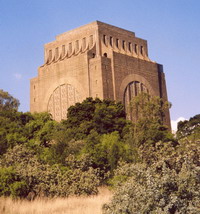
In Afrikaner society, the two world wars were massively divisive. The First precipitated open rebellion with Afrikaners fighting on both sides, and the Second generated clandestine anti-war movements and internment of 'traitors' (at least one of whom, BJ Vorster, later became prime minister). There is also a dearth of major monuments or commemorative days for the Anglo–Boer War — a spectacular act of national denial for the sake of white unity. War memorials thus fail to unite Afrikaners, and commemorative events like Poppy Day were always unofficial. Later, as part of a wider attempt to unite all white South Africans behind the apartheid government, many of the war memorials that did exist were re-engineered to honour those who died in the border wars against the African independence movements. The Voortrekker Monument, although commemorating a defeat of Indigenous people, was more fundamentally a unifying symbol for Afrikaners after their earlier defeat and domination by Britain. It was a commemoration of the triumph of Christian civilisation over paganism and also a celebration of a very particular white heritage. From a distance, the Voortrekker Monument cuts a solid, sinister silhouette on the horizon. It is meant to be seen. One suspects that it is meant to instil fear — or at least a stolid immovability. It is classic fascist architecture.
We visited the Voortrekker Monument late on its special day, after the speechmaking and feasting had finished (during which it was open only to guests). At midday on this Day of the Covenant the sun had already shone through the aperture in the building's dome, lighting up the words on the cenotaph at its centre: ONS VIR JOU SUID-AFRIKA ('We for thee South Africa'). In a 'Hall of Heroes', 27 panels of marble friezes depict the history of the trek and the arrival of enlightenment and order. A small oil lamp, the 'Light of Civilisation', burns in the crypt — and symbolically illuminates the dark, barbaric interior of the African continent. The building re-enacts the laager, for it is surrounded by an outdoor frieze of ox-wagons, and some of the wagon windows house night-lighting for the monument.[5]
Since democracy in 1994, Dingane's Day has become Reconciliation Day. By a stroke of genius, the negotiating council, CODESA (Convention for a Democratic South Africa), resisted the temptation to abolish it and instead embraced it, tweaking it to new uses. Afrikanerdom has become a minority culture meriting preservation in the Rainbow Nation. It is not very happy to be multi, but it is cultural. As we discovered, ceremonies still take place at the Monument, although now much diminished in popularity and power. There is a great speechmaking arena below the hill but it is grassing over. Once, this arena throbbed to the rhetoric of National Party politicians. Looking at its emptiness now, one is impressed by the vanity and transience of power. Yet, if we had been in Church Square in central Pretoria (now to be called Tshwane) a few hours earlier, we would have heard an echo of it. There, under the statue of top-hatted Paul Kruger and surrounded by Dutch architecture, Eugene Terre'Blanche, recently released from prison for assaulting a black man, had dismounted from his horse and declared: 'We have lost everything. We have lost our country'. Dressed in khaki, surrounded by old Boer Republic flags and with an ox-wagon parked nearby, Terre'Blanche announced: 'I've come to gather the volk. The volk must get together again and go into a laager'. Nearby at Freedom Park, at the official Reconciliation Day celebrations, President Thabo Mbeki said: 'We need to confront what may be an uncomfortable question — whether as South Africans, black and white, we are under the same flag and under the same anthem marching separately, even pretending at times that the other does not exist'.[6]
There are lots of impressive walls in Johannesburg. Some are prettily coloured, some are crenellated, some are softened with ivy, and all are high, forbidding, and mostly topped with razor wire and labelled with 'Armed Response' promises. Johannesburg is a famously violent city with a very high crime rate. The number of security walls has increased since democracy. They were always a part of white South African life, but they have proliferated as the public spaces have increasingly been ceded to the blacks. The social engineering of apartheid aimed to marginalise, even export, blacks from white South Africa, but now they are free to recolonise — and dominate — shared spaces. There is still a huge divide, symbolised by the Johannesburg suburbs of Dainfern and Diepsloot, one rich and the other poor, one mostly white and the other entirely black, First World and Third cheek by jowl, connected by little but a sewerage pipe. There was a nice irony in driving to the Apartheid Museum across a rejuvenated and dangerous central Johannesburg. People thronged the streets, markets spilled across the footpaths, and some buildings looked abandoned. One felt on the edge of control. While we drove through the CBD, 16 armed men were holding up a department store around the corner.
The Apartheid Museum tells the story of the liberation, and Mandela is its hero. The museum offers a history of the Struggle and of the ideology it fought against. This is a fascinating and satisfying museum, mostly because it is not written just for 12-year-olds, which is the age curators are told to imagine as their audience. When you enter the museum, you are randomly assigned racial status, given a plastic pass, and separated from your family or companions. There is chilling news footage of National Party leaders of the 1950s and 1960s sweetly explaining apartheid, as if to primary school pupils, as a policy of 'good neighbourliness'. Grim as its subject is, the Apartheid Museum benefits from Mandela's Prison-Cell-to-President fairytale, the evident evil of the apartheid regime and the righteousness of the opposition. But one wonders how long South Africans can find a future consensus by damning the past? For a little while yet, surely. The relief of escape is still palpable. But one question posed by the Apartheid Museum is: How can the ANC be uncorrupted by its newfound dominance? Where will a genuine and healthy opposition come from? There is a surprising resonance in this question for Australians under John Howard in the first decade of the twenty-first century.
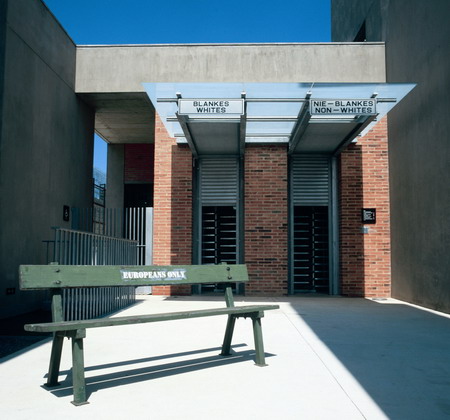

Fig. 4. The footprint logo of Maropeng
Maropeng
Until the post-war era, the origins of humanity had been confidently expected to be found in Europe or Asia. Fossils such as the Taung skull (an Australopithecine), found by the Australian Raymond Dart on the fringes of the Kalahari desert in 1924, had first raised the possibility that Africa was, as Charles Darwin had predicted, the Cradle of Humankind. And it was at Sterkfontein Caves, not far from Maropeng, that Robert Broom — supported by Jan Smuts — had extracted further evidence of early hominins and strengthened Africa's claim. But it was not until the post-war years, and ironically as apartheid became institutionalised and archaeology in South Africa became politically constrained, that the African origins of humanity became widely accepted. Saul Dubow has explored the complex relationship in South Africa between theories of essential racial difference and white supremacist thinking.[9]
Maropeng celebrates the theory that all humans came out of Africa. The earlier exodus, when Homo erectus or Homo ergaster found its way into Europe and Asia and even onto the island of Flores, began about two million years ago and is known as 'Out of Africa 1'. The later exodus, known as 'Out of Africa 2', was of Homo sapiens, and happened as recently as 100,000 to 200,000 years ago.[10] The Out of Africa 2 thesis is also called the 'Replacement model', because it supposes that when Homo sapiens spread around the globe during the last 200,000 years, it replaced Homo erectus and Homo ergaster populations without interbreeding with them. Tracing back the chromosomes of our mothers shows that we all recently came from an African Garden of Eden; we are all descended from an African Eve. Therefore, racial characteristics are skin-deep. The diversity of the modern world is recent and cultural rather than ancient and biological. The theory that all present humanity came out of Africa so recently, that we are all one species, that race is cosmetic, that Africa was our common birthplace, that the Third World was actually our First World is an irresistible and powerful parable, particularly on a globe still recoiling from the scientific racism of the Holocaust, and in a country trying to recover from apartheid. Furthermore, it is genetic research — DNA sequencing — that has revealed the story. It is biology that has delivered the coup de grâce to the biological theory of race. But the very appeal of the parable can overwhelm its fascinating complications. Walking around Maropeng a week after its opening in December 2005, we were struck as much by the politics as the science.
What are the uses of the deep past in contemporary South Africa, a nation trying to shed its apartheid past and seeking to foster 'an African renaissance'? Here is a small collection of the captions of Maropeng:
My humanity is bound up in yours, for we can only be human together.
Archbishop Desmond TutuThere is no genetic boundary for race. We are one species.
Homo sapiens, the species to which we all belong, evolved in Africa.
All of humanity shares an African heritage.
The greatest single challenge facing our globalised world is to combat and eradicate its disparities.
Nelson MandelaAfrica is the birthplace of humankind. This is where our collective umbilical cord lies buried.
Humans emanated from Africa to the four corners of the globe.
We are one global species with an African heritage.
The message is so strong and repetitive that one is forced to reflect on the politics of it all. The Colonies Strike Back! A colonised continent becomes The Cradle. Maropeng gives voice to Africa's own piece of imperialism. So President Thabo Mbeki writes in his foreword to the Field Guide to the Cradle of Humankind: 'After many years of struggle to liberate Africa from colonialism and apartheid, the entire continent is now on the threshold of a great renaissance.'[11] Maropeng positions Africa in the world and South Africa in Africa. In this sense, Maropeng is just as much a product of post-apartheid politics as the Apartheid Museum in Johannesburg. Both recoil from the laager, the mindset of inward-looking, defensive isolation. Both renegotiate a relationship with the world, and urgently articulate new understandings of race and humanity.
Maropeng subtly continues the national denial of the Anglo–Boer War, or at least a reluctance to commemorate it in any significant way. This monument to homogeny is sited on a small but significant Boer War battlefield without so much as a brass plate to record the fact. The Battle of Dwarsvlei on 11 July 1900 contributed to the resurgence of the Boer war effort and was the scene of conspicuous courage on both sides: three Victoria Crosses in one day and the almost suicidal death of one of the best Boer generals. The battle was fought along the new access road to Maropeng.[12] Museums have to entertain as much as educate and so you enter the exhibition via a boat ride. You sit in a four-seater, circular boat, and are launched into a canal that floats past fibreglass evocations of the four ancient elements: water, fire, earth and air. But there is no information here, just waterfalls and precarious, hilarious (and slightly dangerous) stage scenery. The boat ride panders unashamedly to the 12-year-old in all of us. We began it with our hopes high, but these were quickly dashed: the ride has nothing to do with the exhibition or the site. The ride simply establishes the 'theme-park' credentials, but, sadly, it's not even very exciting. You disembark from the boat rather perplexed and then wander into an underground gallery with a number of sideshow or casino-style interactive exhibits, some of which had, in just one week since the opening, fallen into disrepair.
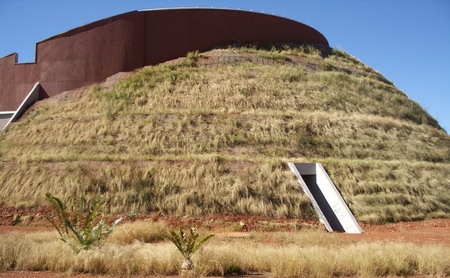
The meaningless boat ride alerts us to the power of designers in the making of this museum. With so much site-specific evidence available, there would seem no need to have a theme park or to import or manufacture motifs and metaphors. But, perhaps because it seeks to tell a universal human story, Maropeng feels free to indulge in generalities and to take symbols out of context — hence the surprising use of a tumulus or burial mound as the centre's architectural shape and metaphor. Burial mounds were not commonly used in southern Africa, but they were certainly a feature of northern European cultures. One wonders if this may have been the Swedish influence on the funding consortium. Scientists and curators were frustrated by the overruling power of designers and architects as well as the politicised government committee that has had a tense relationship with academic palaeontologists in the Cradle. At the time of writing (almost a year after the opening of Maropeng), the scientific committee have not yet given it their formal approval and have not signed off the scientific integrity of the exhibits. A list of high priority corrections and modifications is now being addressed by the Maropeng authorities to meet the scientists' requirements.[13] But even before construction was complete, Maropeng had won three major awards: the best new tourism project worldwide, best civil engineering and building contract, and best public–private partnership. Museums don't even need to have content to be a success these days. This would not be the first museum whose form, inside and out, has been driven chiefly by architects, designers and politicians rather than scholars and curators. One can discern the influence of both business and government on the science and history at Maropeng.
Sometimes political goodwill can stifle science as much as ill will.[14] Both phases of the Out of Africa model are currently under scientific challenge. In the past decade, Asia's earliest hominin presence has been extended up to 1.8 million years ago and emerging fossil evidence suggests a variety of tool-making hominins possibly moving between Africa and Asia. Robin Dennell and Wil Roebroeks argue that the dominance of the Out of Africa 1 paradigm is stifling a rigorous evaluation of sparse data.[15] The chief opposing theory to the Out of Africa 2 model is also given little attention at Maropeng, yet it remains a credible thesis. It is called the 'multiregional' hypothesis. It argues that, following the early movement of ancient humans into Eurasia, a subdivided population continued to exist within and outside Africa and may have mixed with subsequently migrating groups. Early humanity may have recolonised Africa from outside. The multiregional model was championed earlier in the twentieth century by some scientists with an explicitly racist purpose. They built on older nineteenth-century polygenist traditions that presumed deep and hierarchical racial distinctions. So the multiregional hypothesis suffers from this ugly political legacy: racial science indeed killed off the science of race. However, more evidence is emerging for aspects of multiregional evolution. Recent reports of Pleistocene human remains from the island of Flores — the so-called 'hobbits' — show that the process of replacement by modern humans of earlier established populations was not simply accomplished in an initial wave of expansion. Sheila van Holst Pellekaan and Rosalind Harding argue that growing evidence of long periods of the coexistence of several hominins in Asia, as in Europe, raises questions about the possible genetic contribution of ancient forms of humans to the modern gene pool. This includes the conundrum of the Neanderthals — archaeologically, they appear to be fully modern humans and they shared Europe with Homo sapiens as recently as 30,000 years ago. But they were physically distinct. Did they contribute to the modern gene pool?[16] The possibility cannot be ruled out. In other words, racial characteristics may have deeper histories than we are allowed to recognise. And the multiregional hypothesis is, in some ways, less racial than the African Eve theory. Out of Africa is an imperial thesis that posits 'a Pleistocene holocaust', the violent, genocidal replacement of one hominin by another. The multiregional hypothesis allows for cohabitation, coevolution and interbreeding. It has its own positive political potential but it may not suit a Third World country battling for intellectual space in a modern scientific paradigm.
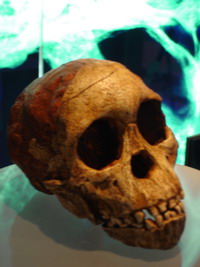
Fig. 6. Cast of the Taung child skull, in the exhibit at Sterkfontein caves
Maropeng
Maropeng acknowledges that modern humans reached Australia. But an Australian perspective has much more to offer this debate. The Australian contribution to the global human story remains — as it has always been — intriguing. Australia was populated by modern humans probably about 50,000–60,000 years ago. The long ocean-crossing to reach the burning continent was the first great adventure of modern humans — and that event remains one of the few solid pegs in the shifting ground of world human history. Our current estimation of the timing of this migration fits in — just — with the Out of Africa 2 theory. But DNA research with living Aboriginal people is now revealing the extraordinary genetic diversity of Australia's founding populations. Genetic variation in particular Australian Aboriginal groups is similar to that found across the whole of Asia.[17] Darren Curnoe and Alan Thorne argue that this evidence shows that 'Australia was settled over a long period by people carrying mtDNA probably originating in disparate regions of Asia'.[18] In other words, the same science that established the African Eve hypothesis is now complicating its own foundation story. How could this diversity have come about? This is a story we don't yet understand — and one with huge ramifications for global human history. But there is no space for it at Maropeng. Perhaps as a result of these shortcomings, the World Heritage Site authority felt it necessary to have another, more scientific museum next to the famous cave at Sterkfontein, and an 'Origins Centre' has been opened at the University of the Witwatersrand. The Institute for Human Evolution in Johannesburg is also destined to have a public exhibition and interpretive centre.
In the early twenty-first century, the deep past offers a troubled Africa much solace. In Australia, by contrast, the deep past is culturally contested, as it was in South Africa in the 1920s. In the Cradle of Humankind, you will find many skulls on display. In Australia it is not yet possible to make so much of skulls — because they are tens of thousands of years old rather than millions, and politically they are Aboriginal heritage before they are human heritage. Also, science and myth are in disagreement in Australia, for many Aboriginal people believe they have always been here. In New Zealand there is a statue on the Wellington waterfront of a Maori family first sighting Aotearoa. Amongst New Zealanders, with such a recent human occupation, immigration is a uniting experience. In Australia, with an ancient Indigenous inheritance, humans are no more all Out of Africa than they are all Out of Europe. And it's likely that Australasian archaeology, palaeontology and molecular anthropology still have some surprises in store for the people at Maropeng.
We are grateful to Jane Carruthers, Libby Robin, Tim Partridge, Laura Haden Smith and Mike Smith for inspiration and assistance.
1 'Sydney blitz after racial clashes' and 'Guantanamo man now a Brit', The Star (Johannesburg), 14 December 2005, p. 4.2 Saturday Star, 17 December 2005, p. 12.
3 For astute and illuminating commentaries on the connections and contrasts between South Africa and Australia, see Jim Davidson, 'Sisters of the south: South African connections and comparison', Australian Studies, vol. 12, no. 2, winter 1997, 69–77, 'Packing for Perth and other considerations: White English-speaking South African attitudes to Australia', Meanjin, vol. 59, no. 3, 2000, 43–55, and 'Out of Africa, by England', Meanjin, vol. 56, no. 2, 1997, 281–94, and Jane Carruthers, 'Contesting cultural landscapes in South Africa and Australia: Comparing the significance of the Kalahari Gemsbok and Uluru-Kata Tjuta national parks', in David Trigger and Gareth Griffiths (ed.), Disputed Territories: Land, Culture and Identity in Settler Societies, Hong Kong University Press, Hong Kong, 2003, chapter 9.
4 Allister Sparkes, The Mind of South Africa, William Heinemann Ltd, London, 1991 (first published in Great Britain in 1990), p. 111.
5 Sparkes, The Mind of South Africa, pp. 110–11; Albert Grundlingh, 'A cultural conundrum? Old monuments and new regimes: The Voortrekker Monument as symbol of Afrikaner power in a postapartheid South Africa', Radical History Review, vol. 81, fall 2001, 95–112; and Andrew Crampton, 'The Voortrekker Monument, the birth of apartheid, and beyond', Political Geography, vol. 20, 2001, 221–46.
6 'Racial walls still define us', Saturday Star, 17 December 2005, p. 2.
7 Maropeng, Visitors' Centre brochure, 2005.
8 'Mbeki opens Maropeng Centre', online news report at www.news24.com.
9 Saul Dubow, Scientific Racism in Modern South Africa, Cambridge University Press, Cambridge, 1995.
10 Some key texts on these theories, especially Out of Africa 2, are: RL McCann, M Stoneking and AC Wilson, 'Mitochondrial DNA and human evolution', Nature, vol. 325, 1987, 32–36; R Klein, 'Archaeology and evolution of human behaviour', Evolutionary Anthropology, vol. 9, 2000, 17–36; C Stringer and R McKie, African Exodus: The Origins of Modern Humanity, Henry Holt, New York, 1996; and Donald Johanson and Blake Edgar, From Lucy to Language, Witwatersrand University Press, Johannesburg, 1996.
11 Thabo Mbeki, Foreword to Brett Hilton-Barber and Lee R Berger, Field Guide to the Cradle of Humankind, Struik Publishers, Cape Town, revised edition, 2004, pp. 4–5.
12 Vincent Carruthers, 'The Anglo–Boer War in the Cradle of Humankind', in Phillip Bonner, Amanda Esterhuysen and Trefor Jenkins (eds), A Search for Origins: Science, History and South Africa's Cradle of Humankind, chapter 13 (in press).
13 Tim Partridge, Chairman of the scientific committee, pers. com.
14 Robert N Proctor, 'Three roots of human recency: Molecular anthropology, the refigured Acheulean, and the UNESCO response to Auschwitz', Current Anthropology, vol. 44, no. 2, April 2003, 213–39.
15 Robin Dennell and Wil Roebroeks, 'An Asian perspective on early human dispersal from Africa', Nature, vol. 438, 22/29 December 2005, 1099–1104.
16 Sheila van Holst Pellekaan and Rosalind Harding, 'Excavating the mitochondrial genome identifies major haplogroups in Aboriginal Australians', Before Farming, (in press).
17 Van Holst Pellekaan and Harding, 'Excavating the mitochondrial genome'.
18 Darren Curnoe and Alan Thorne, 'Human origins in Australia: The skeletal evidence', Before Farming, 2006 (in press).
